Note: The charts in this commentary have been updated to include the latest monthly data.
Our monthly market valuation updates have long had the same conclusion: US stock indexes are significantly overvalued, which suggests cautious expectations on investment returns. In a “normal” market environment — one with conventional business cycles, Federal Reserve policy, interest rates and inflation — current valuation levels would be a serious concern.
But these are different times. The economic cycle shaped by the Financial Crisis that began emerging in 2007 shortly after the Bear Stearns hedge funds collapsed. The Fed began its historic crusade in cutting the overnight rate from an average of 5.25% prior to the hedge fund collapse to ZIRP (Zero Interest Rate Policy) as of December 16, 2008. The bankruptcy of Lehman Brothers on September 15, 2008 was the most dramatic precipitator of the Fed’s unprecedented policies.

In the wake of the Financial Crisis, inflation has been low and the 10-year Treasury yield, as of the February close, is about 150 basis points above its historic closing low of 1.37% in early July of 2016. So, with this refresher on the Financial Crisis in mind, let’s take another look at the popular P/E10 valuation metric.
Here is a scatter graph with the market valuation on the vertical axis (log scale) and inflation on the horizontal axis. It includes some key highlights: 1) the extreme overvaluation and irrational period of the Tech Bubble, 2) the valuations since the start of last recession, 3) the average P/E10 and 4) where we are today.

The latest P/E10 valuation is 32.0 at a 2.30% year-over-year inflation rate, which is in the sweet spot mentioned above, however, the P/E10 valuation is in extreme valuation territory.
P/E10 and the 10-Year Treasury Yield
A common question is whether a valuation metric such as the P/E10 has any merit in a world with Treasury yields at current levels. Investors who require portfolio growth might indeed be motivated to disregard historic indicators that warn of an overvalued market. But what does history show us about the correlation between the P/E10 and the 10-year constant maturity yield? The next scatter graph offers some clues. The horizontal axis has been switched to the 10-year yield. The chart uses a log scale to better illustrate the relative yields values.









Leave A Comment